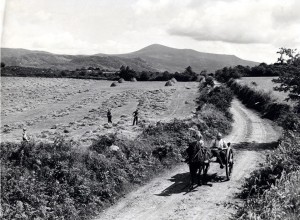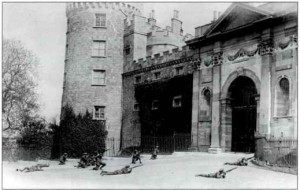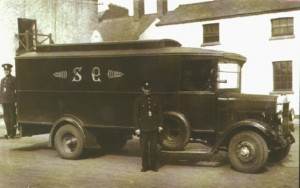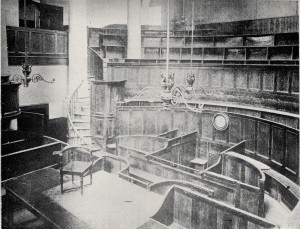“Don’t tell your mother or I’ll kill you.” The murder of baby William Holden, 1923.

Colm Wallace tells the story of a shocking crime in rural Kilkenny in April 1923.
After the Civil War finished the Irish court system found itself with a long backlog of criminal cases needing to be tried. The death penalty was imposed many times in 1923 [1] but surely one of the most shocking crimes to come before the courts involved Kilkenny native Patrick Aylward.
In 1923 the new Irish Free State handed out 65 death sentences. Patrick Aylward was very nearly the 66th.
The killing of defenceless children is an especially repugnant crime. It is impossible to fathom why someone would commit such an act. Unbelievably, Aylward’s motivation was said to have been a long-running feud with his neighbours. The question remains, almost a century after this strange trial, however; did Patrick Aylward murder an infant to exact revenge on a family he despised?
Patrick Aylward of Rochestown and the Holdens

Patrick Aylward was a farmer from the townland of Rochestown, a mile and a half from Mullinavat in South Kilkenny. Like many defendants at the time, contemporary records did not state his age, merely describing him as “middle-aged”.
In many cases in the early part of the last century, the people themselves were unsure how old they were as many had no birth certificate at all.
Instead they often described themselves as “middle-aged,” “elderly,” “about 35 or 36” and so on. Aylward, it transpired from later prison records, was born in 1860, making him about 63 years old at the time of the murder. He had spent nearly forty years in America, spending most of his time in Connecticut where he made plated cutlery.
He decided to return to Kilkenny in 1922 to take care of his two elderly brothers, both of whom still lived on the family farm. One brother, William, had since died leaving Patrick to earn a living on their twenty-five acre farm for himself and John, his remaining sibling. Fifty yards away from the Aylward homestead lived their neighbours, the Holden family. The family included Patrick, his wife Mary and their eight children. Relations between the two households were not good.
Patrick Aylward, a 63 year old bachelor farmer, got on badly with his neighbours the Holdens, whom he accused of trespassing onto his land.
Patrick Aylward had complained many times about the alleged trespassing on his land by fowl and goats which belonged to the Holden family. On one occasion, Aylward set his dog on a goat belonging to Mrs. Holden which had wandered onto his land. After this incident a dead fowl belonging to the Holdens was found in the haggard of Aylward.
Mary Holden described her neighbour as violent and said that he had twice struck her with his stick. Aylward would deny this accusation, later telling the authorities that Mary Holden was “of the tramp class” and that the Holden family had a campaign of intimidation against him, even involving their children.
He asserted that the mother of the Holden household had attacked him on more than one occasion while her sons constantly annoyed his animals and had used his well as a toilet. What started out as a minor disagreement was about to take a far more sinister turn.
The assault on baby William Holden
On the evening of Saturday, the 21st April 1923, Patrick Holden was out at work while his wife was minding the children. At 5pm, Mary put her eighteen month old baby William to bed. She then left for the nearby townland of Lisronan where she was planning to buy an outfit for her eldest son’s confirmation scheduled for the following week.
Despite the unsettled conditions brought on by the Civil War, the Holdens left eight year old Patrick in charge of his infant brother William.
The spring of 1923 was a particularly dangerous time with the Civil War still ongoing and crime rampant. Despite this, the Holdens saw fit to put eight-year-old Patrick in charge of the house. They told him to lock the door from the inside and stay there.
He was left with his brother Michael, his sister Mary and the infant, William. William, the second youngest of the Holden family, was a “very feeble child, barely able to move hand or foot.” He suffered from rickets and was not able to crawl or walk. His mother said “he would stay (in bed) for a month without leaving it.” That is where he was, sleeping peacefully, when his mother left.
Some minutes afterwards, Patrick Aylward allegedly walked the short distance over and rapped at the door of the Holden house, demanding admittance. Patrick, Michael and William were all in the kitchen at this point. After some deliberation, they opened the door to their neighbour. When Aylward entered the room he turned around to the door and twisted the key, re-locking it from the inside. He next extracted the key and put it in his pocket before allegedly telling the children that he “would put an end to the trespassing.” William was still lying down asleep in a bed near the fire wrapped in swaddling clothes.
The Holden children alleged that Patrick Aylward entered their house and held their baby brother William over a fire, burning him badly.
Aylward, the Holden children said, lifted the small boy and walked over to the fire in which sticks were burning. He then allegedly held the infant down over the burning grate. Patrick Holden endeavoured to intervene but he was powerless against the strength of the older man. Aylward stayed watching the crying infant as he burned on the fire, all the while using a stick to hold off the other children making sure they could not aid their infant brother.
Just as William’s clothes caught fire, Aylward said “Don’t let them goats into my haggard anymore” before dropping the key and striding out the door. The other children quickly removed their infant brother down from the burning-hot grate and put him in a bucket of water to try and quench the flames. They then put the severely-burned baby back into his bed and locked the door.
Patrick Holden Snr. arrived home within the next few minutes to be met with several hysterical children and a baby suffering from life-threatening burns. There were no Gardaí in the area at that turbulent point in Irish history, so Holden instead sent for a local GP. The doctor had to come from Waterford, a journey of over ten miles, and consequently he did not arrive until the next morning.
Meanwhile the Holdens wrapped the baby in cotton wool and waited. When Dr. Coghlan finally called he knocked at the back door of the house. Mary Holden, unsure of who it was, did not answer the door as she was too afraid. Coghlan then saw Patrick Aylward walking by and asked him if that was the Holden’s house. Aylward told him that it was before adding “they’re all mad over there.”
When the doctor was eventually admitted to the Holden house, he described the baby’s condition as follows: “He was in a state of collapse…charred black all over the back and over the lungs. There were burns on both the arms towards the elbows.” William Holden was subsequently brought to hospital but died within twenty-four hours of the incident. His death was attributed to toxaemia, a type of blood poisoning caused by the heat he was subjected to.
The case against Patrick Aylward

Early on the morning after the tragedy, Patrick Holden went to Aylward’s house and accused him of roasting his son. Patrick Aylward strenuously denied it, implying that the Holdens had told their children to tell lies about him.
The coroner’s inquest took place just days after the murder. Aylward appeared and denied having any part in the burning, claiming that he had no grudge against the Holden family.
Nevertheless, the jury recommended that the Gardaí pursue the matter further. The coroner called the case a sad and regrettable occurrence. He had harsh words for the Holdens as well, however, telling them that he did not know whether to sympathise with them because they “left this little infant and three other little children and went away a quarter of a mile from home.” Aylward was arrested on the 8th May. He replied “I did not do it.”
Patrick Aylward denied the allegations, saying that the Holdens were ‘of the tramp class’.
Patrick Aylward’s murder trial began on the 26th November, just days after William Devereux’s death sentence was pronounced. The evidence of the Holden children was critical to the case against Aylward. Mr. Carrigan, prosecutor, described the prisoner as “charged with a crime which, if proved against him, was as terrible and hideous a crime as any one described as a human being could commit.”
Aylward himself, permitted by the court to sit for the duration of the trial, maintained a “cool demeanour” throughout, despite the gravity of the charges against him. He pleaded not guilty to the charge.
The prosecution characterised Aylward as a strange and immoral creature. They described his house as “not fit for human habitation. He kept cattle on the ground floor…and lived in his loft. The place was a veritable cesspool and manure heap.” When Dr. Matthew Coghlan took the stand, he was asked about the condition of the young boy and whether the other children could have accidently inflicted such wounds on him if they had taken him out of the bed to play with him.
The doctor stated that he did not believe that William Holden’s injuries could have occurred accidently as they were too severe. He added that as the boy had been suffering from rickets, a disease usually caused by malnutrition, his bones were seriously underdeveloped. For this reason the doctor replied that the infant could not, in his opinion, have got out of bed and burned himself on the fire.
He was further questioned about the character of the accused, Aylward. Coughlan described him as a “degenerate” and said that when he met him he “made up his mind that he was mentally abnormal.” He opined that the accused was responsible for his actions, however, and capable of distinguishing right from wrong.
The next witness was 9-year-old Patrick Holden. Holden was described as an intelligent witness, although he had never gone to school and was unable to write his name. He gave his account of the tragic day. He described letting Aylward into the house. Aylward asked him “what do you want to leave the goats in the haggard for?” he then broke a mug and searched under the bed for something.
After getting up he fell along the bed. Finally he grabbed William and put him across the fire, holding his back against the burning grate. Patrick described trying to take William off the fire and how Aylward would not let him near his brother. Another younger son in the house, Michael, also appeared on the stand and to recount the events of the day. He described Aylward had raised a stick at them as they attempted to rescue their infant brother. As he left the house, Aylward said “Don’t tell your mother or I’ll kill you.”
“Don’t you think I have a soul to save as well as everyone else, or what do you think I am?” He also said “I could not bear to look at a child burning on the fire, not to mind do it myself.” Patrick Aylward.
Aylward admitted to the court that he had been around the Holden house with goats earlier in the day but had not burned the child, adding “Don’t you think I have a soul to save as well as everyone else, or what do you think I am?” He also said “I could not bear to look at a child burning on the fire, not to mind do it myself.”
He told the court that he was “thunderstruck” at the accusation that he had harmed William Holden and that when Mr. Holden had accused him he thought his neighbour “was getting out of his mind.” Patrick Aylward told the court that he did not know why the Holden children would be telling lies about him but he thought they had been put up to it by their parents.
A local farmer, James O’Keeffe, spoke for the defence. He stated that he had arrived at the Aylward house at 4:45pm, around the time the burning was supposed to have taken place. He had stayed until night-time having tea with Aylward and his brother. John Aylward, 75-year-old brother of the accused, also gave the accused man an alibi. He stated that he and Patrick had been tending a sick cow all day and were in the house from the early evening until 9:15pm and that his brother had not left at any stage.
Patrick Aylward told the court that the last time he had been inside the Holden household was five months before the tragedy when he had gone over to tell Mrs. Holden to stop her sons from chasing his sow. He claims that on this occasion Mrs. Holden hit him with a scrubbing brush and he had hit her back with his walking stick. The defence also reminded the jury that Mrs. Holden had not mentioned Aylward in her initial evidence to the authorities, merely stating that the child had been burnt.
The trial took just one day and despite the contentious and contradictory evidence the all-male jury needed just ten minutes deliberation before passing a guilty verdict. A majority of the jury did, however, give a recommendation to mercy on Patrick Aylward for the wilful murder of William Holden.
The judge commented that he agreed wholeheartedly with the verdict before passing the sentence of death on the prisoner. On hearing the sentence, Aylward remarked “I am not guilty at all. I have not been in that house for five months. May God forgive the woman who put the lie on me and God forgive the jury.”
The judge said he would pass on the recommendation to mercy to the appropriate quarters but went on to say that he “could not hold out any hope of mitigation of the sentence he was about to impose.” Aylward was sentenced to death, to be carried out two days after Christmas on the 27th December. He was sent to Mountjoy Gaol to await his fate.
December 1923, a month of hangings

Five executions were scheduled for the month of December 1923, due to the backlog caused by the Civil War. It would be the busiest ever time at the gallows of the Irish State.
Thomas Delaney and Thomas McDonagh were executed within half an hour of each other. Delaney had attacked and killed 74-year-old Patrick Horan with a pair of tongs and a slasher in the course of a robbery. Horan was an elderly shopkeeper from Banagher, Co. Offaly and Delaney was disturbed in the act by locals.
Five hangings were scheduled for December 1923.
His guilt was not in question and he would pay the ultimate penalty for the crime. McDonagh had killed his neighbour, Ellen Rogers, in Loughglynn, Co. Roscommon. The two had fallen out years before and had an argument about money. McDonagh went home, retrieved his shotgun and shot Rogers dead.
Unusually, McDonagh had asked not to be visited by his wife in the lead up to the execution. Peter Hynes also faced the hangman. A native of Drogheda, Hynes had killed a soldier named Thomas Grimstone in Co. Meath. Hynes claimed he believed Grimstone was a “Black and Tan.” He had beaten him to death in the middle of the night with an iron bar and then concealed his body underneath straw and hay in a loft. He too was convicted and hanged. William Devereux was more fortunate than any of the above. He received a last-minute reprieve, possibly due to question marks over his mental condition.
The reprieve
Patrick Aylward, who had attracted national attention for his unspeakable brutality against a helpless child, could not have been too hopeful of a commutation in light of the frequent use of the death penalty at the time. However numerous local people, including the Bishop of Ossory, petitioned government minister Kevin O’Higgins, questioning the guilt of the elderly man. They also mentioned the Holden family’s “bad moral character,” and alluded to a previous incident when another Holden child had been burned to death in suspicious circumstances.
Aylward’s sentence was commuted to Penal servitude after a campaign for clemency by locals including the Catholic Bishop of Ossory.
This tragedy was said to have occurred in Piltown in 1910 but whether there was any substance to this allegation is not known. Either way, it was announced just hours before the execution that Aylward’s death sentence was to be commuted to one of penal servitude for life. The minister was not obligated to give a reason for this sudden commutation but one can only wonder as to whether it was linked to the fact that a man was being put to death solely on the evidence of children. There also seems to have been a reasonable doubt present.
Patrick Aylward served just under ten years in prison, being released under the general amnesty in 1932 in honour of the Eucharistic Congress. His brother had died shortly after the trial so Patrick resided in an old persons’ home in Kilkenny after his release. He died there three years after his release in November 1935. To the end, he maintained that the Holden family had framed him and strenuously denied having any part in the burning of William Holden.
Colm Wallace has written a book “Sentenced to Death: Saved from the Gallows” about thirty Irish men and women who had the death penalty imposed on them between 1922 and 1985. It is being launched on the 17th June this year and is available for pre-order on book.ie or Amazon.com. For more information see http://www.somervillepress.com/sentence.html
Note
[1] There were 61 Civil War executions in 1923 enacted by military courts and four more after convictions in civil courts after the conflict had ended.
Sources
The main sources of this article are;
Irish Newspaper Archives 1922 – 1935;
The National Archives, Department of Justice Files; Census 1911
Military Archives 1922.